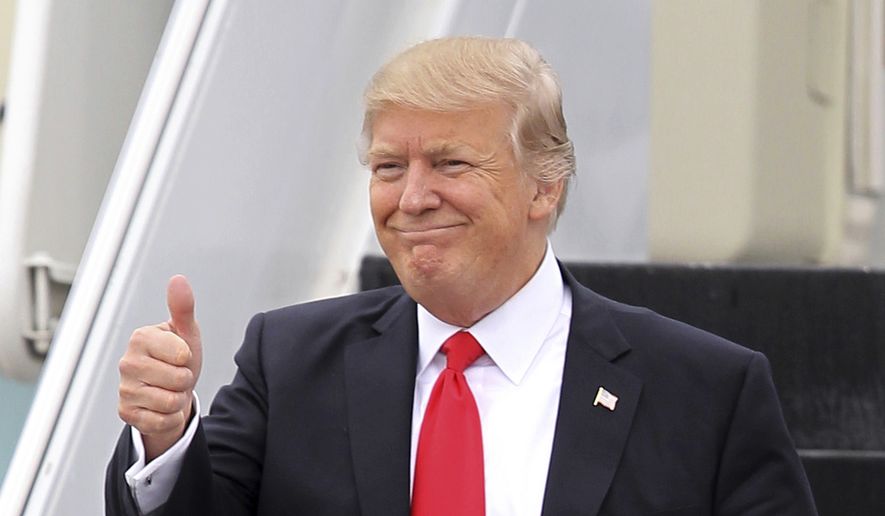With President Trump promising historic tax cuts this year, the White House said Wednesday it’s counting on spurred job growth and budget cutting to stem a continued rise in deficits.
“One of the best ways to get the national debt down is to grow the economy,” said White House press secretary Sean Spicer. “The more the economy is growing — the more we can get it [between] 3 [percent and] 5 percent — the more the deficit goes down.”
Mr. Trump hinted broadly during a meeting with House Republicans this week that the tax-cut plan is mostly finished, saying, “most of us know exactly the plan,” and that it will be as big or bigger than tax cuts under President Ronald Reagan.
Grover Norquist, president of Americans for Tax Reform, said the main points of the tax reform plan are “pre-baked” for action by Congress after Obamacare is addressed.
“The House and the White House are on the same page,” Mr. Norquist said. “The Senate is largely on the same page, and a whole bunch of senators have already committed their votes. The governors have been brought in over the last several months.”
He said the result over a decade will be $1 trillion in tax cuts from the repeal and replacement of Obamacare, $1 trillion in tax cuts for businesses and $1 trillion in tax relief for individual taxpayers.
“It’s huge,” Mr. Norquist said. “You can coast the rest of your presidency, go out and cut ribbons and build infrastructure. When Ronald Reagan got his tax cut through, the rest of his presidency was possible. The economy was roaring.”
He said the tax-cut plan will help push through the repeal of Obamacare, because tax reform won’t be possible unless the health care law is addressed first.
House Republicans released a plan for comprehensive tax reform in June, including lowering tax rates on businesses and individuals at every income level, simplifying the tax code and eliminating loopholes, and turning the IRS into an agency that is primarily focused on customer service. Lawmakers are planning to introduce tax legislation this summer.
While the final details of a tax plan haven’t been written, broad areas of agreement are taking shape. Among them are cutting the corporate income tax from 35 percent to 20 percent, lowering the top individual tax rate from 39.6 percent to 33 percent, repealing the Alternative Minimum Tax and abolishing the so-called “death tax.”
Employers are showing signs of responding to the proposed tax overhaul and the administration’s efforts to cut red tape. New jobs surged in February, with employers hiring about 298,000 workers, beating economists’ expectations by nearly one-third.
The report from the payroll firm ADP on Wednesday provided the first data on Mr. Trump’s first full month in office. The government’s report on the jobless rate for February is due Friday.
“February proved to be an incredibly strong month for employment with increases we have not seen in years,” ADP Research Institute Vice President Ahu Yildirmaz said in a statement.
Mr. Trump said on Twitter that the number of new jobs added was “much more than expected!” He also cited a LinkedIn report that showed strong job growth in January and February, calling those months “the strongest consecutive months for hiring since August and September 2015.”
During the campaign, Mr. Trump cited the need for tax cuts, saying U.S. corporate taxes are too high compared with the European average of about 25 percent.
Under the plan being considered this year, individual income rates would be 33 percent, 25 percent and 12 percent, with capital gains taxed at half those rates.
Speaking about the overall plan, Mr. Spicer cautioned Wednesday, “We’re not there yet.”
But if the tax cuts do reach historic levels, the administration will be hard-pressed to hold down deficits, which are projected to grow to more than $1 trillion in a few years.
Administration officials assert that Mr. Trump’s efforts at budget-cutting, combined with increased tax revenue from more and higher-paying jobs, will help the government control red ink.
“The best way to tackle the deficit is to grow the economy and put people back to work [and] create a deeper manufacturing base,” Mr. Spicer said. “Between that and some of the efforts the president has put in to make government more efficient and effective and save money at that level. Those are the two things that I think combine to get the deficit down.”
• Dave Boyer can be reached at dboyer@washingtontimes.com.




Please read our comment policy before commenting.